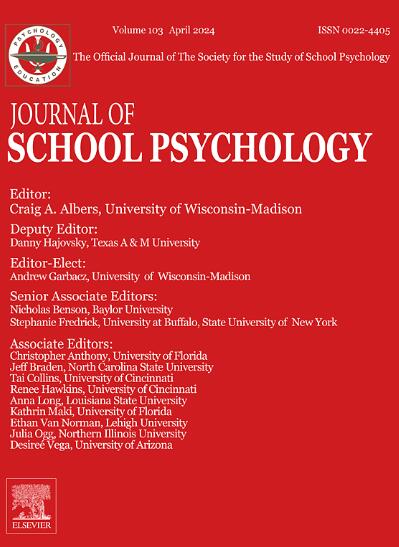A review of research on the school climate of transgender middle and high schoolers: An ecological-transactional approach
IF 4.1
1区 心理学
Q1 PSYCHOLOGY, SOCIAL
引用次数: 0
Abstract
Research that aims to identify the characteristics of school climate for transgender middle and high school students is still a new domain. This narrative review of the literature attends to this gap by aggregating recent research on school protective factors which inform trans middle and high school students' school climate and relate to their wellness outcomes. The review was guided by the ecological-transactional model to capture the multi-dimensional quality of school climate, including overlapping levels of the environment that inform protection and risk, and students' perceptions navigating these spaces. More specifically, this framework was applied to help identify aspects of the school ecology that are theoretically salient features of school climate for transgender middle and high school students. Although most research that applies developmental systems is guided by minority stress theory, this review is guided by the gender affirmative model (GAM) to help highlight findings on protection within and between overlapping socio-ecological levels in the school ecology. Supportive faculty allies, peer support, and parent support emerge as strong protective factors at the micro-level. At the exo-level, school programming efforts that are proactive by prioritizing a discourse that nurtures agency for trans students show to be the most protective. There is some evidence that suggests proximal level indicators are more protective than distal level for transgender middle and high school students. The advantages of a multi-level approach to school climate for trans students are discussed.
跨性别初高中学生学校氛围研究综述:生态交易视角
跨性别初高中学生校园氛围特征的研究仍是一个新的领域。这篇文献的叙述性回顾通过汇总最近关于学校保护因素的研究来弥补这一差距,这些因素为跨性别初中生和高中生的学校气候提供了信息,并与他们的健康结果有关。该评估以生态交易模型为指导,以捕捉学校气候的多维质量,包括为保护和风险提供信息的环境的重叠水平,以及学生对这些空间的感知。更具体地说,这个框架被应用于帮助确定学校生态的各个方面,这些方面在理论上是跨性别初中生和高中生学校气候的显著特征。尽管大多数应用发展系统的研究都以少数群体压力理论为指导,但本综述以性别肯定模型(GAM)为指导,以帮助突出学校生态中重叠社会生态水平内部和之间的保护发现。在微观层面上,支持性的教师盟友、同伴支持和家长支持成为强有力的保护因素。在外部层面,通过优先考虑培养跨性别学生代理能力的话语,积极主动的学校规划工作被证明是最具保护性的。有证据表明,近端水平指标对跨性别初高中学生的保护作用大于远端水平指标。讨论了跨性别学生的学校氛围多层次方法的优势。
本文章由计算机程序翻译,如有差异,请以英文原文为准。
求助全文
约1分钟内获得全文
求助全文
来源期刊

Journal of School Psychology
PSYCHOLOGY, EDUCATIONAL-
CiteScore
6.70
自引率
8.00%
发文量
71
期刊介绍:
The Journal of School Psychology publishes original empirical articles and critical reviews of the literature on research and practices relevant to psychological and behavioral processes in school settings. JSP presents research on intervention mechanisms and approaches; schooling effects on the development of social, cognitive, mental-health, and achievement-related outcomes; assessment; and consultation. Submissions from a variety of disciplines are encouraged. All manuscripts are read by the Editor and one or more editorial consultants with the intent of providing appropriate and constructive written reviews.
 求助内容:
求助内容: 应助结果提醒方式:
应助结果提醒方式:


